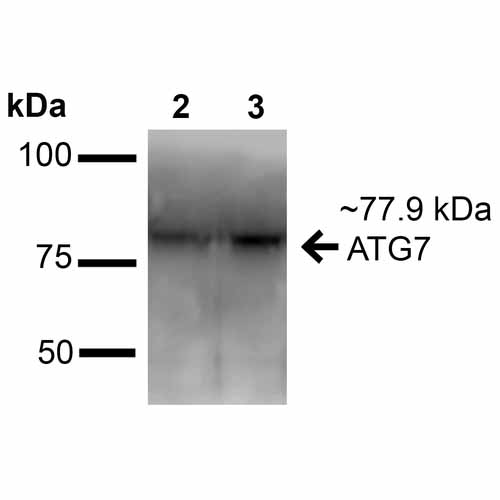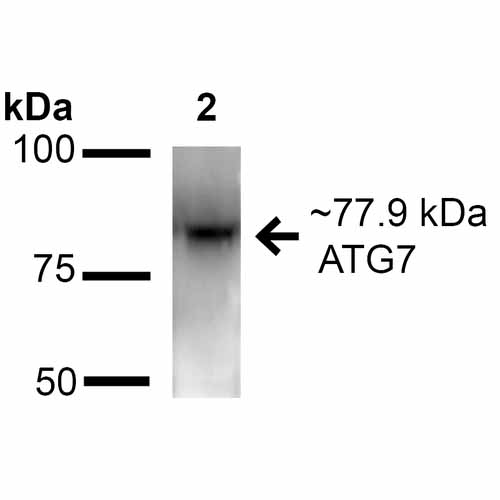ATG7 Antibody
- SPECIFICATION
- CITATIONS
- PROTOCOLS
- BACKGROUND

Application
| WB |
|---|---|
| Primary Accession | O95352 |
| Other Accession | NP_001129503.2 |
| Host | Rabbit |
| Reactivity | Human, Mouse, Rat |
| Clonality | Polyclonal |
| Description | Rabbit Anti-Human ATG7 Polyclonal |
| Target/Specificity | Detects 77.9 kDa. |
| Other Names | Autophagy 7S. cerevisiae, homolog of Antibody, APG7 like Antibody, ATG7_HUMAN Antibody, hAGP7 Antibody, Ubiquitin-like modifier-activating enzyme ATG7 Antibody, Autophagy related protein 7 Antibody, Autophagy-related protein 7 Antibody, GSA 7 Antibody, APG7, S. cerevisiae, homolog of Antibody, Ubiquitin-activating enzyme E1-like protein Antibody, Autophagy-related 7 (yeast) Antibody, APG7 autophagy 7 like Antibody, 1810013K23Rik Antibody, APG7 autophagy 7-like (S. cerevisiae) Antibody, ATG12-activating enzyme E1 ATG7 Antibody, ATG7 autophagy related 7 homolog Antibody, Atg7l Antibody, Ubiquitin activating enzyme E1 like protein Antibody, Apg 7 Antibody, APG7L Antibody, DKFZp434N0735 Antibody, ATG 7 Antibody, APG7-like Antibody, GSA7 Antibody, ATG7 autophagy related 7 homolog (S. cerevisiae) Antibody, ATG7 Antibody |
| Immunogen | Synthetic peptide from the C-terminal of Human ATG7 |
| Purification | Peptide Affinity Purified |
| Storage | -20ºC |
| Storage Buffer | PBS, 50% glycerol, 0.09% sodium azide |
| Shipping Temperature | Blue Ice or 4ºC |
| Certificate of Analysis | A 1:1000 dilution of SPC-609 was sufficient for detection of ATG7 in 15 µg of human HeLa cell lysates by ECL immunoblot analysis using goat anti-rabbit IgG:HRP as the secondary antibody. |
| Cellular Localization | Cytoplasm | Preautophagosomal Structure |

Thousands of laboratories across the world have published research that depended on the performance of antibodies from Abcepta to advance their research. Check out links to articles that cite our products in major peer-reviewed journals, organized by research category.
info@abcepta.com, and receive a free "I Love Antibodies" mug.
Provided below are standard protocols that you may find useful for product applications.
Background
ATG7 in conjuction with ATG10, mediates the formation of the autophagosome when ATG12 is covalently bound to ATG5 and targets to autophagosome vesicles. It also activates ATG8, and is crucial for amino acid supply in neonates.
References
1. Mizushima N., et al. (1998) J Biol Chem. 273: 33889-92.
2. Mizushima N., et al. (1998) Nature. 395: 395-8.
3. Suzuki K., et al. (2001) EMBO J. 20: 5971-81.
4. Tanida I., et al. (1999) Mol Biol Cell. 10: 1367-79.
5. Shintani T., et al. (1999) EMBO J. 18: 5234-41.
If you have used an Abcepta product and would like to share how it has performed, please click on the "Submit Review" button and provide the requested information. Our staff will examine and post your review and contact you if needed.
If you have any additional inquiries please email technical services at tech@abcepta.com.













 Foundational characteristics of cancer include proliferation, angiogenesis, migration, evasion of apoptosis, and cellular immortality. Find key markers for these cellular processes and antibodies to detect them.
Foundational characteristics of cancer include proliferation, angiogenesis, migration, evasion of apoptosis, and cellular immortality. Find key markers for these cellular processes and antibodies to detect them. The SUMOplot™ Analysis Program predicts and scores sumoylation sites in your protein. SUMOylation is a post-translational modification involved in various cellular processes, such as nuclear-cytosolic transport, transcriptional regulation, apoptosis, protein stability, response to stress, and progression through the cell cycle.
The SUMOplot™ Analysis Program predicts and scores sumoylation sites in your protein. SUMOylation is a post-translational modification involved in various cellular processes, such as nuclear-cytosolic transport, transcriptional regulation, apoptosis, protein stability, response to stress, and progression through the cell cycle. The Autophagy Receptor Motif Plotter predicts and scores autophagy receptor binding sites in your protein. Identifying proteins connected to this pathway is critical to understanding the role of autophagy in physiological as well as pathological processes such as development, differentiation, neurodegenerative diseases, stress, infection, and cancer.
The Autophagy Receptor Motif Plotter predicts and scores autophagy receptor binding sites in your protein. Identifying proteins connected to this pathway is critical to understanding the role of autophagy in physiological as well as pathological processes such as development, differentiation, neurodegenerative diseases, stress, infection, and cancer.



